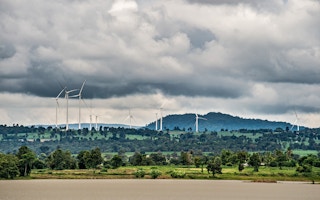The ink has long dried on the world’s first deal to combat climate change, an agreement by 195 nations to keep global temperature rise well below 2 degrees Celsius. Now begins the hard work of ensuring that the world achieves the goal of the treaty, which was signed in Paris in December 2015 and entered into force last November.
As international climate and energy expert Masakazu Toyoda, chairman of the Institute of Energy Economics, Japan (IEEJ), says, the Paris agreement was a success, “but perhaps, to put it more accurately, a great starting point for success”.
“More important is the next step, where all the countries will make improvements to their emission mitigation targets”, says Toyoda, who is also a co-chair on the organising committee of Sustainable Energy & Technology Asia (SETA) 2017, one of Asia’s key events for clean energy technology.
Achieving the massive emissions cuts needed to make the deal a reality is no doubt a politically and scientifically complex global affair; but most experts agree that energy use in Asia is a critical part of the solution.
The International Energy Agency (IEA), for example, has noted that the centre of gravity of the global energy system is shifting towards Asia. In addition to India and China, the 10 nations that make up the Association of Southeast Asian Nations (ASEAN) are the key drivers of this change.
Brunei, Cambodia, Indonesia, Laos, Malaysia, Myanmar, the Philippines, Singapore, Thailand and Vietnam: These countries, home to some 600 million people, make up one of the most dynamic regional blocs in the world, with projected growth rates of as much as 6 per cent a year over the next five years. However, this economic growth has caused the region’s energy demand to increase by more than 50 per cent between 2000 and 2013.
With about 120 million people yet to gain access to electricity in Southeast Asia, IEA predicts that the region’s energy demand will further increase by over 80 per cent between 2013 and 2035, a rise equivalent to Japan’s current energy use. This in turn would double the region’s carbon dioxide emissions from 1.2 gigatonnes (Gt) in 2011—3.7 per cent of the global total—to 2.3 Gt by 2035.
The rise of low carbon technologies
Regional leaders are all too aware of the need to keep its carbon emissions in check even as its energy use grows.
Many of its low-lying and coastal regions are regularly ravaged by floods and typhoons, while the agricultural economies of countries like Vietnam and Cambodia are increasingly threatened by droughts; climate change threatens to exacerbate these extreme weather events.
To curb its emissions, ASEAN has set various targets to improve the region’s use of sustainable energy technologies. This includes cutting its energy intensity by a fifth by 2020 compared to 2005 levels and increasing the share of renewables in its energy mix to 23 per cent by 2025, up from 10.2 per cent in 2013.
“I believe that ASEAN is making its best efforts to address climate change, but their carbon emissions are increasing,” says Toyoda, who has worked in the energy sector since the mid-1970s.
He spent many years working on trade and energy policies issues in the Japanese government, and has headed the IEEJ since 2010, where he oversees the institute’s research on energy and national development issues in Japan.
Toyoda serves as an international advisor to organisations including global consultancy Accenture, the Oxford Institute for Energy Studies, and the Brunei National Energy Research Institute, among others. He says that ASEAN must now focus on four key tasks to align with its energy systems with its climate goals.
These are: improving energy efficiency, promoting the cleaner use of fossil fuels, adopting cheaper renewable energy solutions, and finding safe ways to introduce nuclear energy into the energy mix.
From established technologies such as wind and solar power to controversial solutions such as nuclear power and ‘clean coal’ to emerging disciplines such as electric vehicles, sensors and data analytics solutions for smarter cities, there is a broad range of technologies that policymakers and businesses can adopt to reduce emissions.
Many of these technologies will be on display at the upcoming SETA 2017, which will be held from March 8 to 10 at the BITEC Bang Na event venue in Bangkok, Thailand.
Themed ‘Towards a Low Carbon Society’, the event will host a conference, exhibition, and slew of special networking events to bring together about 5,000 attendees from 42 countries to discuss the latest energy technology and policy issues affecting Asia’s energy landscape.
A key feature of the event is the Low Carbon Expo exhibition, which will feature more than 200 companies showcasing technologies ranging from hybrid and electric vehicles, smart city systems, solar and green building technologies, among others.
“SETA will provide opportunities for policymakers and industry leaders to understand the state-of-the-art technologies available,” says Toyoda, who was invited to co-chair the organising committee by SETA 2017 organisers.
“
One area that ASEAN countries can enhance their efforts is to cooperate and find regional solutions.
Masakazu Toyoda, chairman, Institute of Energy Economics, Japan
A meeting of ideas and policies
Beyond showcasing the latest clean energy technologies, the conference also address the regulatory, technical, and financial obstacles that make it challenging to scale up the adoption of these technologies.
To this end, SETA 2017 will include a three-day conference where Thai government officials, global industry leaders, and academic experts will discuss four key themes: sustainable energy policy and planning; low-carbon electricity generation; green transport and logistics; smart cities and green industry.
SETA 2017 participants can also enrol in a special Business Matching Programme, which will enable them to arrange meetings with potential industry, government, and academic partners in the energy technology and transport sectors.
Through the networking opportunities at the event, “policy leaders can learn from each other and make more appropriate policies and corporate strategies”, says Toyoda.
This will hopefully take the region one step closer to achieving a goal that for many decades has remained unfulfilled: Regional integration.
“One area that ASEAN countries can enhance their efforts is to cooperate and find regional solutions,” says Toyoda. “According to IEEJ’s analysis, regional cooperation would help ASEAN enjoy higher self-sufficiency, reduced energy costs, and lower carbon emissions.”
This is something ASEAN policymakers have long tried to achieve, but has yet to be realised. Projects that have been announced but remain partially completed include a Trans-ASEAN Gas Pipeline, which would involve some 3,000 kilometres of connections between Indonesia and Malaysia and the rest of the region; and an ASEAN-wide power grid.
Experts have attributed the stalled projects to technical, political and regulatory barriers, all of which are challenges that SETA 2017 hopes to help policymakers address.
“The role of SETA is to share the latest technologies and provide good opportunities for leaders in this region to discuss how to cooperate, and to construct a regional energy network,” says Toyoda. “SETA is also a good vehicle for business leaders to learn about emerging technologies as well as investment opportunities.”
SETA 2017 will be held from March 8 to 10 in Bangkok, Thailand. It will feature a conference, cleantech exhibition, and business matching sessions for industry leaders. Click here to learn more and register for the event.











